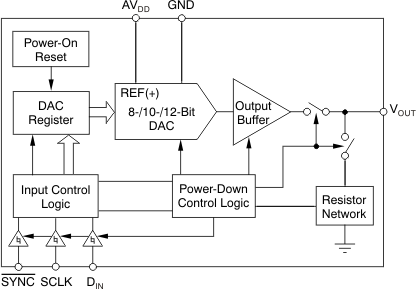-
DACx311 采用 SC70 封装的 2V 至 5.5V、80µA、8 位、10 位和 12 位低功耗、单通道数模转换器
- 1
- 1 特性
- 2 应用
- 3 说明
- 4 Revision History
- 5 Device Comparison
- 6 Pin Configuration and Functions
-
7 Specifications
- 7.1 Absolute Maximum Ratings
- 7.2 ESD Ratings
- 7.3 Recommended Operating Conditions
- 7.4 Thermal Information
- 7.5 Electrical Characteristics
- 7.6 Timing Requirements
- 7.7 Timing Diagrams
- 7.8 Typical Characteristics: AVDD = 5 V
- 7.9 Typical Characteristics: AVDD = 3.6 V
- 7.10 Typical Characteristics: AVDD = 2.7 V
- 8 Detailed Description
- 9 Application and Implementation
- 10Device and Documentation Support
- 11Mechanical, Packaging, and Orderable Information
- 重要声明
DACx311 采用 SC70 封装的 2V 至 5.5V、80µA、8 位、10 位和 12 位
低功耗、单通道数模转换器
1 特性
- 相对精度:
- 0.25 LSB INL(DAC5311:8 位)
- 0.5 LSB INL(DAC6311:10 位)
- 1 LSB INL(DAC7311:12 位)
- 微 功耗运行:2.0 V 时为 80μA
- 断电:5V 时为 0.5μA,2.0V 时为 0.1μA
- 宽电源:2.0V 至 5.5V
- 上电复位至零标度
- 直接二进制数据格式
- 具有施密特触发输入的低功耗串口:高达 50MHz
- 片上输出缓冲放大器,轨到轨运行
- SYNC 中断设施
- 工作温度范围为 –40°C 至 +125°C
- 采用微型 6 引脚 SC70 封装的引脚兼容系列
2 应用
- 便携式电池供电仪器
- 4mA 至 20mA 环路供电应用
- 过程控制和工业自动化
- 可编程电压源和电流源
 简化原理图
简化原理图3 说明
8 位 DAC5311、10 位 DAC6311 和 12 位 DAC7311 (DACx311) 是低功耗、单通道、电压输出数模转换器 (DAC)。DACx311 在正常工作状态下具有低功耗(5V 时为 0.55mW,断电模式下可降至 2.5μW),使其成为便携式电池供电应用的理想选择。
这些器件采用单调性设计,提供出色的线性度,并且大大降低了有害的码字间瞬态电压,同时在引脚兼容系列中提供简单的升级路径。所有器件均使用一个以高达 50MHz 的时钟速率运行的多功能 3 线制串行接口,并与标准 SPI、QSPI、Microwire 和数字信号处理器 (DSP) 接口兼容。
所有器件均使用外部电源作为基准电压来设置输出范围。该器件包含一个上电复位 (POR) 电路,可在 0V 时为 DAC 输出上电,并保持为 0V,直到对器件进行有效写入。DACx311 包含一个由串口访问的断电特性,这将器件处于断电模式时在电压为 2.0V 时的功耗减少至 0.1μA。
这些器件与 DAC8311 和 DAC8411 引脚兼容,可从 8 位、10 位和 12 位分辨率轻松升级到 14 位和 16 位。所有器件均采用小型 6 引脚 SC70 (SOT) 封装。此封装可使本系列中的 DAC 在 –40°C 至 +125°C 的工作温度范围内具有灵活性、实现引脚兼容和功能兼容并且可直接插入使用。
4 Revision History
Changes from Revision C (July 2015) to Revision D (August 2023)
- 更新了整个文档中的表格、图和交叉参考的编号格式Go
- 将英文器件信息表中的“body size”更改为“package size”,并添加了内容以显示不同器件之间的差异Go
- Changed power dissipation max value for normal mode at AVDD = 3.6 V to 5.5 V from 0.88 mW to 0.99 mW in Electrical Characteristics Go
- Changed IDD max value for normal mode at AVDD = 3.6 V to 5.5 V from 160 µA to 180 µA in Electrical Characteristics Go
Changes from Revision B (May 2013) to Revision C (July 2015)
- 添加了 ESD 等级 表和特性说明、器件功能模式、应用和实施、电源相关建议、布局、器件和文档支持 以及机械、封装和可订购信息 部分Go
- Added Device Comparison section and moved existing tables to this new sectionGo
- Moved Operating Temperature parameter from Electrical Characteristics table to Recommended Operating Conditions table Go
- Deleted Parameter Definitions section; definitions moved to new Glossary sectionGo
Changes from Revision A (August 2011) to Revision B (May 2013)
5 Device Comparison
| RELATED DEVICES | 16-BIT | 14-BIT | 12-BIT | 10-BIT | 8-BIT |
|---|---|---|---|---|---|
| Pin and Function Compatible | DAC8411 | DAC8311 | DAC7311 | DAC6311 | DAC5311 |
| DEVICE | MAXIMUM RELATIVE ACCURACY (LSB) |
MAXIMUM DIFFERENTIAL NONLINEARITY (LSB) |
|---|---|---|
| DAC5311 | ±0.25 | ±0.25 |
| DAC6311 | ±0.5 | ±0.5 |
| DAC7311 | ±1 | ±1 |